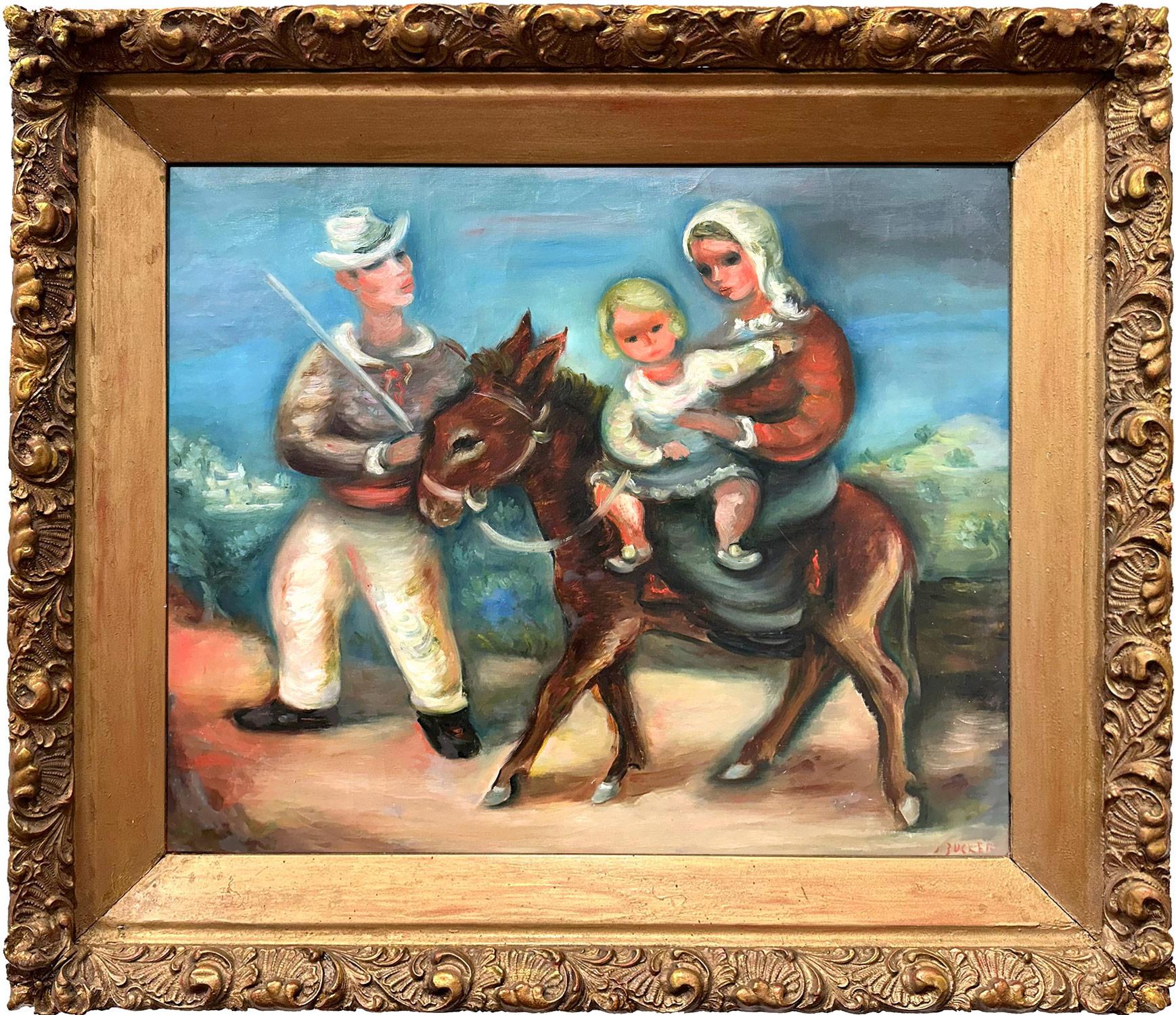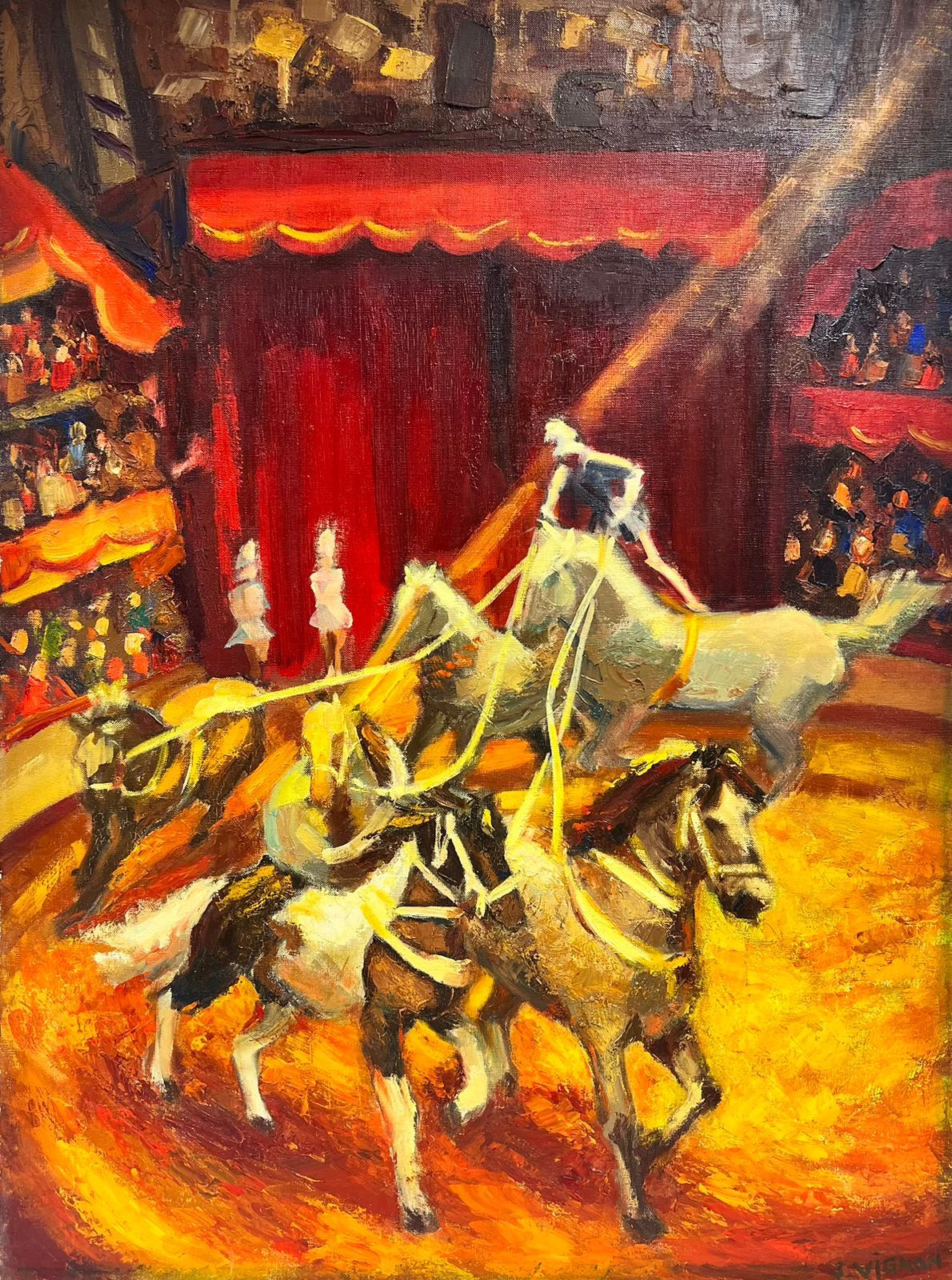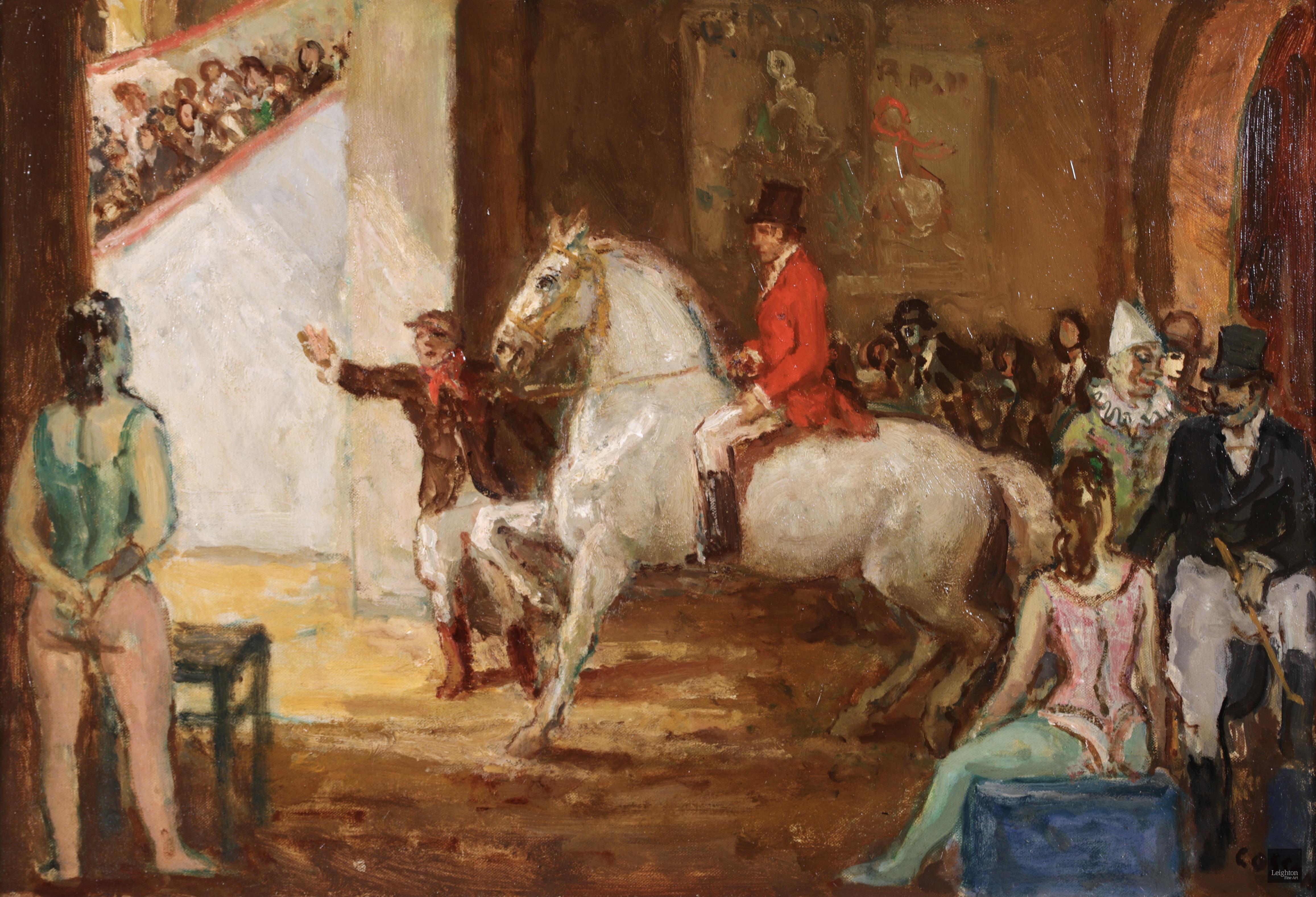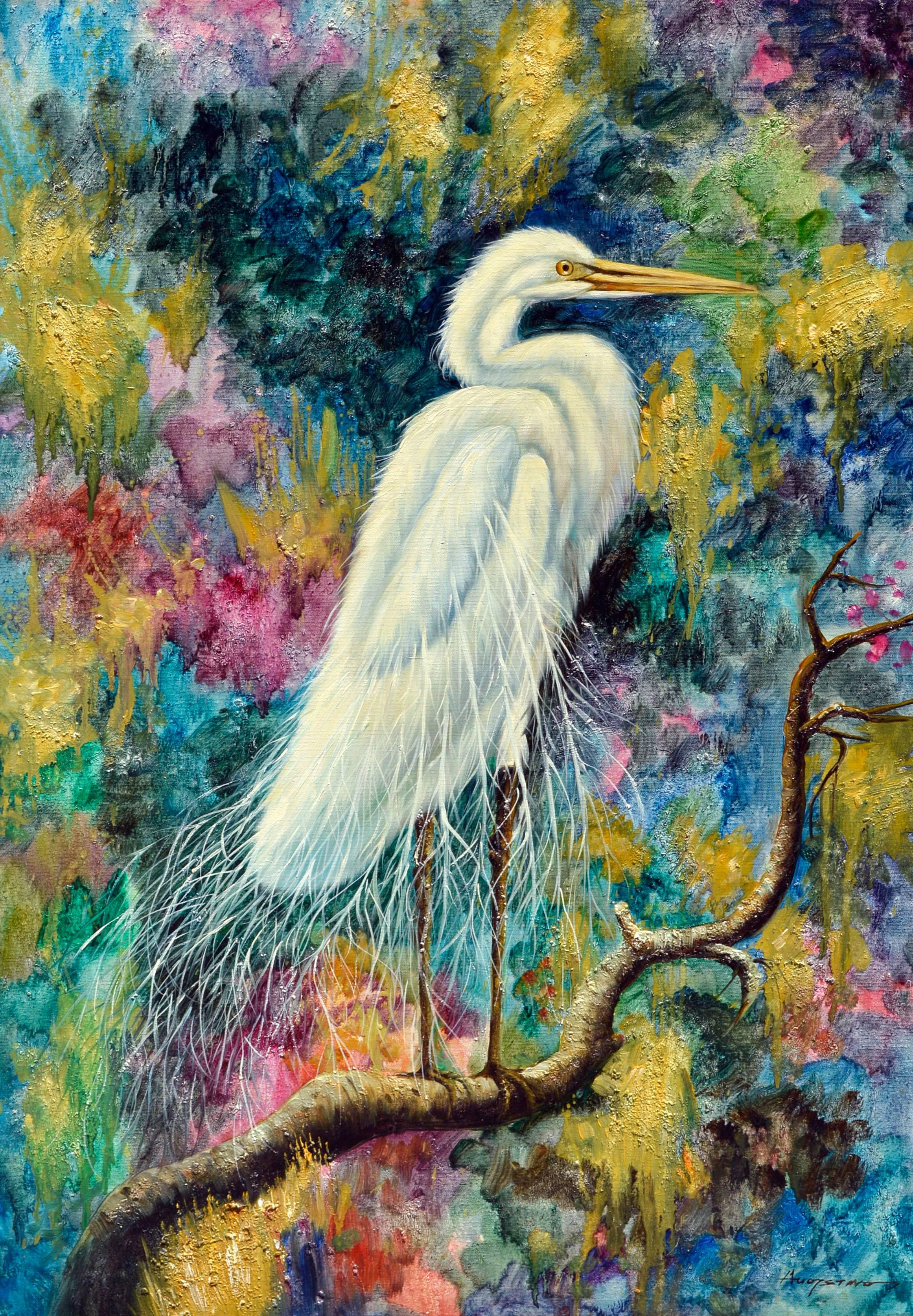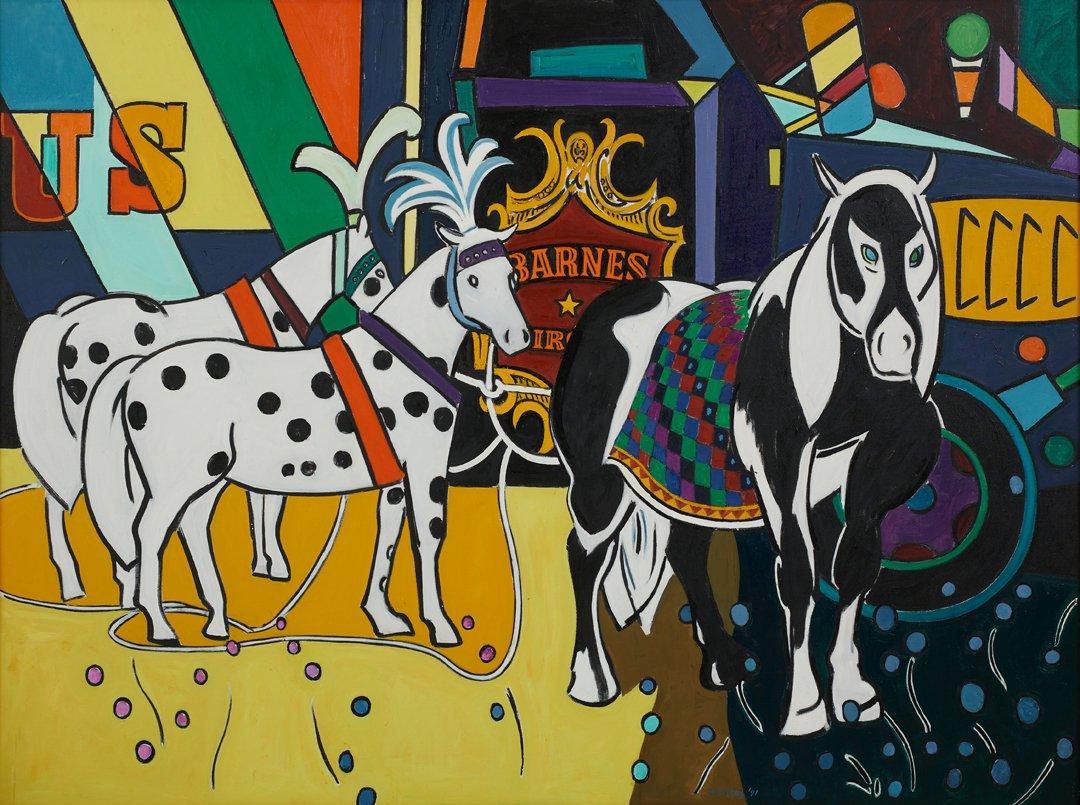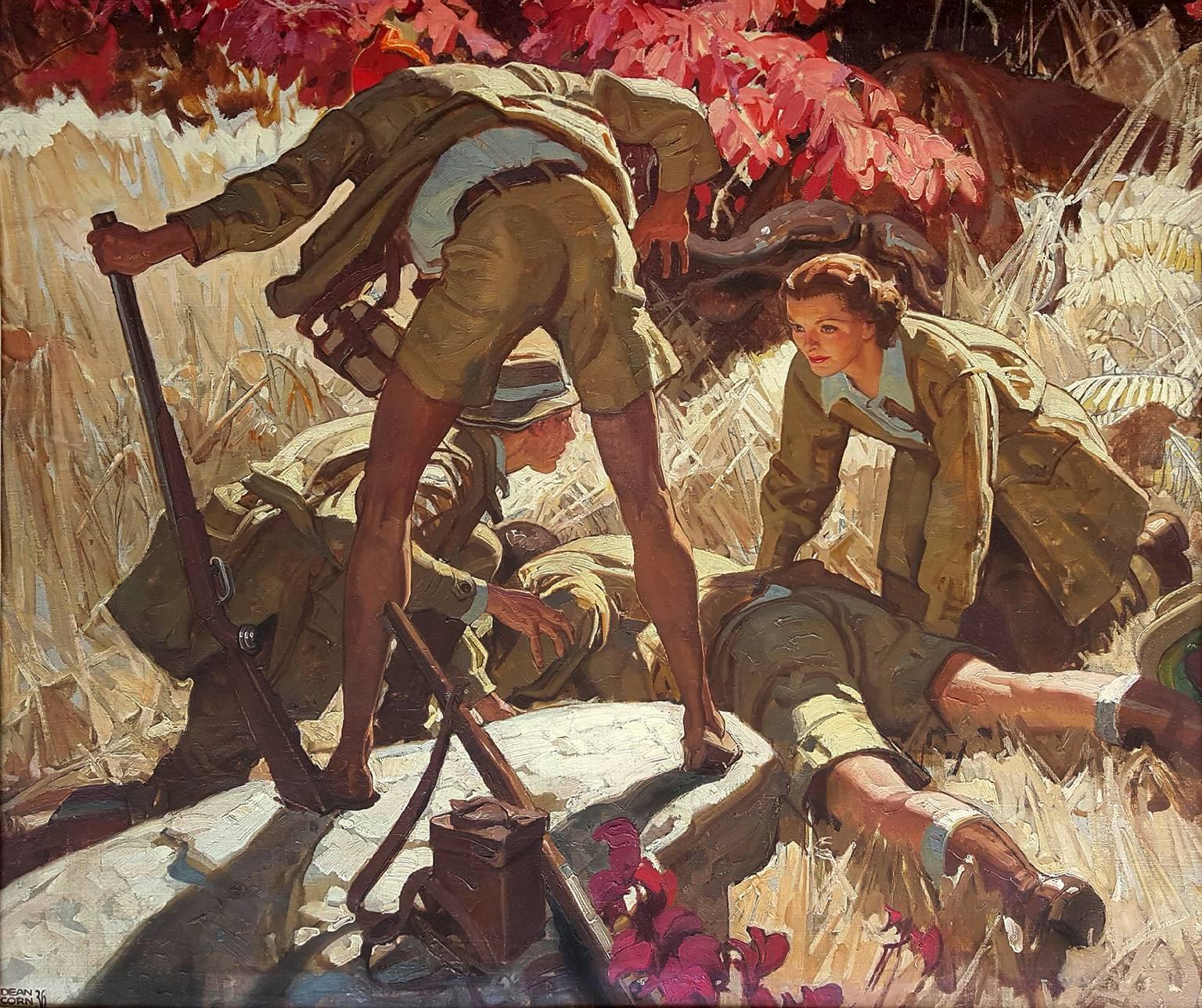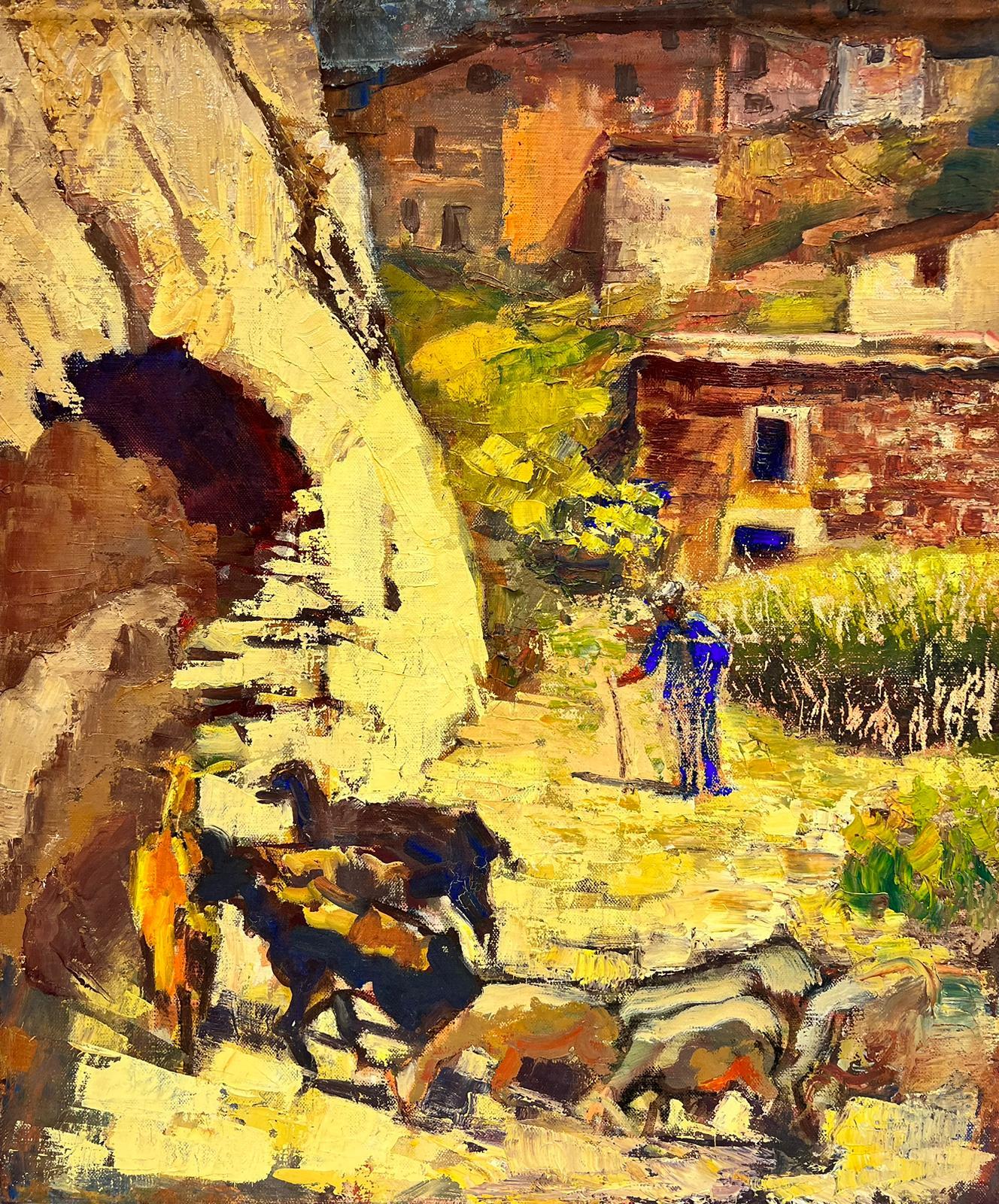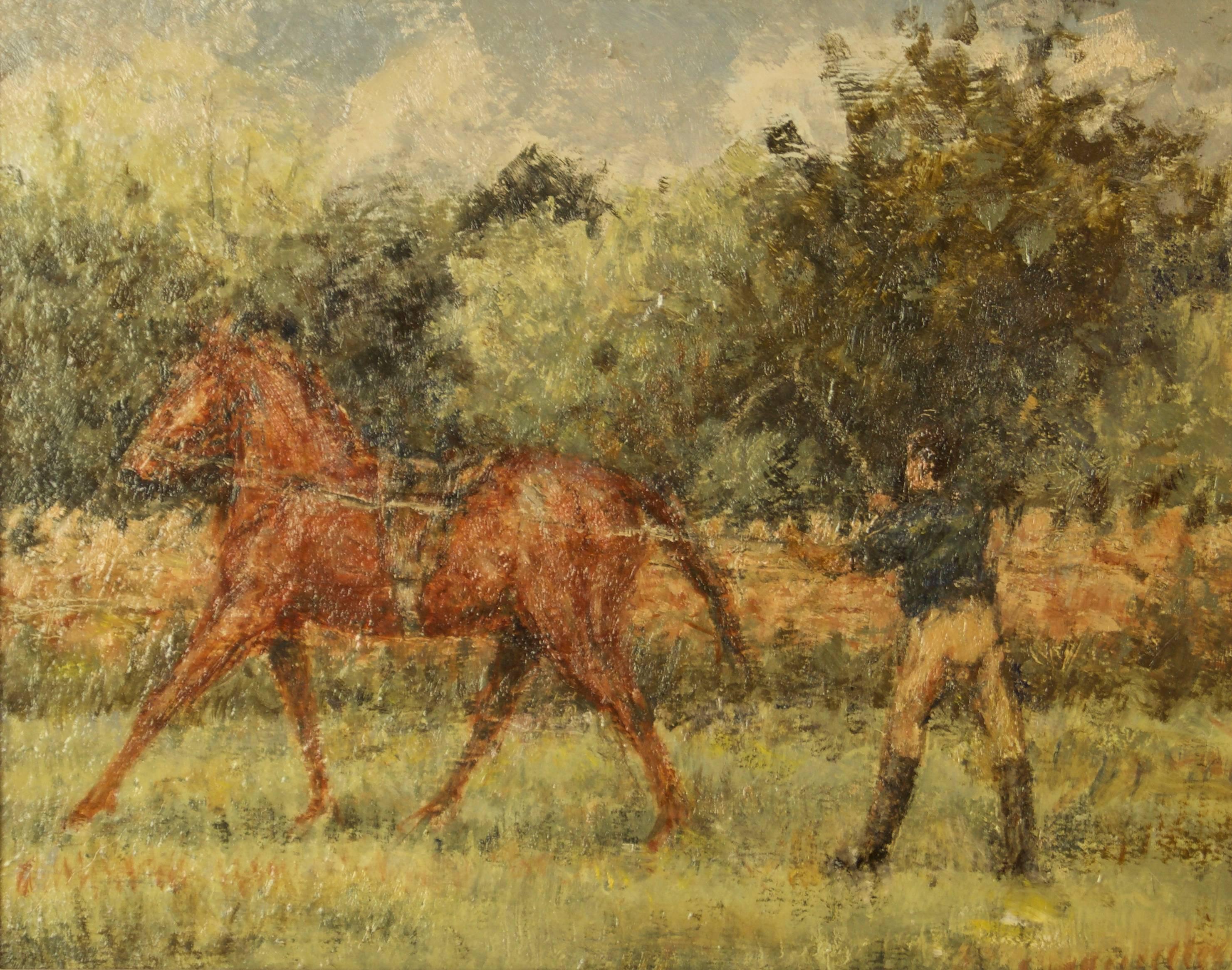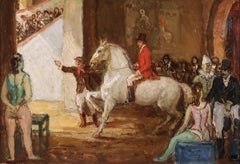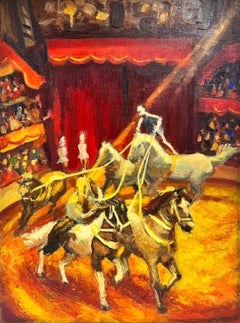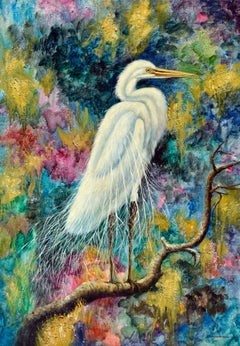
At the Races - Post Impressionist Horses & Figures Oil by Jacques-Emile Blanche
View Similar Items
Want more images or videos?
Request additional images or videos from the seller
1 of 16
Jacques Emile BlancheAt the Races - Post Impressionist Horses & Figures Oil by Jacques-Emile Blanchec.1930
c.1930
About the Item
- Creator:Jacques Emile Blanche (1861-1942, French)
- Creation Year:c.1930
- Dimensions:Height: 28 in (71.12 cm)Width: 36 in (91.44 cm)
- Medium:
- Movement & Style:
- Period:
- Condition:Very good original condition.
- Gallery Location:Marlow, GB
- Reference Number:Seller: LFA1stDibs: LU415310498482
About the Seller
5.0
Platinum Seller
These expertly vetted sellers are 1stDibs' most experienced sellers and are rated highest by our customers.
Established in 2001
1stDibs seller since 2016
673 sales on 1stDibs
Typical response time: 2 hours
More From This SellerView All
- Au Cirque - Post Impressionist Oil, Figures & Horse at Circus by Marcel CossonBy Jean-Louis-Marcel CossonLocated in Marlow, BuckinghamshireSigned oil on board circa 1930 by French post impressionist painter Jean-Louis-Marcel Cosson. The piece gives a behind the scenes look at a French circus. The ringmaster, dressed in ...Category
1930s Post-Impressionist Figurative Paintings
MaterialsCanvas, Oil
- Le Cadre Noir de Saumur - Expressionist Oil, Figures on Horse by André BrasilierBy André BrasilierLocated in Marlow, BuckinghamshireSigned oil on canvas circa 1965 by French expressionist painter Andre Brasilier. The work depicts four military men in French naval uniform on black horses. A wonderful piece in the artist's distinctive style. Signature: Signed: Signed lower left Dimensions: Framed size: 28"x32" Unframed: 20"x24" Provenance: Private French collection André Brasilier was the son of the painter Jacques Brasilier. After studying in Saumur and St-Germain-en-Laye, he joined Brianchon's studio in 1949 at the École des Beaux-Arts in Paris. He was awarded the Prix Florence-Blumenthal in 1952 and the Grand Prix de Rome in 1953. He lived at the Villa de' Medicis from 1954 to 1957. He also received the Prix Charles-Morellet at the Salon de la Jeune Peinture in 1961 and the Prix de Villeneuve-sur-Lot in 1962. Brasilier's paintings are populated by beautiful, elegant women, respectable nudes and high-class gentlemen and are set in pleasant Val-de-Loire backgrounds, resplendent with landscapes and charming towns. Revealing the distant inspiration of Gauguin and the well-assimilated influence of certain other artists, Brasilier depicts a peaceful, comfortable world, free from care, in a very simple, stylish manner, with delicate harmonies bathed in accommodating sunlight. Brasilier took part in group exhibitions from 1956, including many in Paris: at the Salon de la Jeune Peinture; regularly at the Salon d'Automne; at the École de Paris exhibition at the Galerie Charpentier (1954-1957); at the Paris Biennale (1961 and 1963); and at the Salon Comparaisons (1961-1964). Mainly, however, he showed his work in solo exhibitions, including: at the Galerie Drouet in Paris (1959); at the Galerie Weil in Paris (1960 and 1964); at the David B. Finlay Gallery in New York (1962, 1971 and 1974); at the Atelier Mourlot in Paris (1964); at the Galerie Guiot in Paris (1967); at the Galerie de Paris (1969, 1972 and 1976); at the Yoshii Gallery in Tokyo (1969, 1974 and 1977); at the Galerie Matignon in Paris (1979); a first retrospective at the Château de Chenonceau in Paris (1980); at the Nichido Gallery in Tokyo (1983); a retrospective at the Musée Picasso in Antibes...Category
Mid-20th Century Expressionist Animal Paintings
MaterialsCanvas, Oil
- Gardeuse de Moutons - Impressionist Figure in Landscape Oil by Julien DupreBy Julien DupréLocated in Marlow, BuckinghamshireSigned impressionist oil on canvas figure and animals in landscape by French painter Julien Dupre. The work depicts a shepherdess resting on a log as her sheep graze in the green mea...Category
1880s Impressionist Animal Paintings
MaterialsOil, Canvas
- L'embarquement de boeufs - Impressionist Oil, Cattle by Jean Francois RaffaelliBy Jean-Francois RaffaelliLocated in Marlow, BuckinghamshireWonderful signed oil on panel cattle and figures in landscape by French impressionist painter Jean-Francois Raffaelli. The work depicts oxen being loaded onto ships in Honfleur, France en route to England. Signature: Signed lower right Dimensions: Framed: 18"x16" Unframed: 9"x8" Provenance: Exhibition Jean Francois Raffaélli held at Galerie Simonson, 19 Rue Caumartin Paris - October 1929 (number 44) Jean-François Raffaëlli's father was a failed Italian businessman and Raffaëlli himself was, among other things, a church chorister, actor and theatre singer. He then studied under Gérôme at the École des Beaux-Arts in Paris. He travelled to Italy, Spain and Algeria and on his return to France settled in Asnières. In 1876, on a trip to Brittany, he first saw the potential of realist subject matter, if treated seriously. He became involved in meetings of artists at the Café Guerbois, where the Impressionist painters used to gather. As a result, Degas, contrary to the advice of the group, introduced Raffaëlli to the Impressionist exhibitions - according to one uncertain source as early as the very first exhibition, at the home of Nadar, and certainly to those of 1880 and 1881. In 1904, Raffaëlli founded the Society for Original Colour Engraving. He first exhibited at the Salon de Paris in 1870 and continued to exhibit there until he joined the Salon des Artistes Français in 1881, where he earned a commendation in 1885, was made Chevalier of the Légion d'Honneur in 1889 and in the same year was awarded a gold medal at the Exposition Universelle. In 1906 he was made Officier of the Légion d'Honneur. He was also a member of the Société Nationale des Beaux-Arts. In 1884, a private exhibition of his work cemented his reputation. He contributed to several newspapers such as The Black Cat (Le Chat Noir) in 1885 and The French Mail (Le Courrier Français) in 1886 and 1887. He published a collection entitled Parisian Characters, which captured his favourite themes of the street, the neighbourhood and local people going about their lives. In 1880 he participated, with Forain, on the illustration of Joris Karl Huysmans' Parisian Sketches (Croquis Parisiens). He also illustrated Huysman's Works. As well as working as an illustrator, he also made etchings and coloured dry-points. His early attempts at painting were genre scenes, but once he was settled in Asnières he started to paint picturesque views of Parisian suburbs. From 1879 onwards, his subject matter drew on the lives of local people. These popular themes, which he treated with humanity and a social conscience, brought him to the attention of the social realist writers of the time such as Émile Zola. In addition to his realist style, Raffaëlli's dark palette, which ran contrary to the Impressionist aesthethic, helped to explain the opposition of those painters to his participation in their exhibitions. More concerned with drawing than colour, he used black and white for most of his paintings. Towards the end of his life, he lightened his palette, but without adopting any other principles of the Impressionist technique. After painting several portraits, including Edmond de Goncourt and Georges Clémenceau, he returned to genre painting, particularly scenes of bourgeois life. Later in his career, he painted mainly Breton-inspired sailors and views of Venice. His views of the Paris slums and the fortifications, sites which have almost completely disappeared, went some way towards establishing a genre in themselves and perpetuated the memory of the area: The Slums, Rag-and-Bone Man, Vagabond, Sandpit, In St-Denis, Area of Fortifications. His realistic and witty portrayal of typical Parisian townscapes accounts for his enduring appeal. Born in Paris, he was of Tuscan descent through his paternal grandparents. He showed an interest in music and theatre before becoming a painter in 1870. One of his landscape paintings was accepted for exhibition at the Salon in that same year. In October 1871 he began three months of study under Jean-Léon Gérôme at the École des Beaux-Arts in Paris; he had no other formal training. Raffaëlli produced primarily costume pictures until 1876, when he began to depict the people of his time—particularly peasants, workers, and ragpickers seen in the suburbs of Paris—in a realistic style. His new work was championed by influential critics such as J.-K. Huysmans, as well as by Edgar Degas. The ragpicker became for Raffaëlli a symbol of the alienation of the individual in modern society. Art historian Barbara S. Fields has written of Raffaëlli's interest in the positivist philosophy of Hippolyte-Adolphe Taine, which led him to articulate a theory of realism that he christened caractérisme. He hoped to set himself apart from those unthinking, so-called realist artists whose art provided the viewer with only a literal depiction of nature. His careful observation of man in his milieu paralleled the anti-aesthetic, anti-romantic approach of the literary Naturalists, such as Zola and Huysmans. Degas invited Raffaëlli to participate in the Impressionist exhibitions of 1880 and 1881, an action that bitterly divided the group; not only was Raffaëlli not an Impressionist, but he threatened to dominate the 1880 exhibition with his outsized display of 37 works. Monet, resentful of Degas's insistence on expanding the Impressionist exhibitions by including several realists, chose not to exhibit, complaining, "The little chapel has become a commonplace school which opens its doors to the first dauber to come along."An example of Raffaëlli's work from this period is Les buveurs d'absinthe (1881, in the California Palace of Legion of Honor Art Museum in San Francisco). Originally titled Les déclassés, the painting was widely praised at the 1881 exhibit. After winning the Légion d'honneur in 1889, Raffaëlli shifted his attention from the suburbs of Paris to city itself, and the street scenes that resulted were well received by the public and the critics. He made a number of sculptures, but these are known today only through photographs.[2] His work was also part of the painting event in the art competition at the 1912 Summer Olympics. In the later years of his life, he concentrated on color printmaking. Raffaëlli died in Paris on February 11, 1924 Museum and Gallery Holdings: Béziers: Peasants Going to Town Bordeaux: Bohemians at a Café Boston: Notre-Dame; Return from the Market Brussels: Chevet of Notre-Dame; pastel Bucharest (Muz. National de Arta al României): Market at Antibes; Pied-à-terre Copenhagen: Fishermen on the Beach Douai: Return from the Market; Blacksmiths Liège: Absinthe Drinker...Category
1880s Impressionist Animal Paintings
MaterialsOil, Panel
- Radiant Autumn -Wakken - Post Impressionist Oil, Cows in Landscape - Modest HuysLocated in Marlow, BuckinghamshireSigned and dated divisionist landscape oil on canvas by Belgian post impressionist painter Modest Huys. This stunning piece is titled "Radiant Autumn - Wak...Category
Early 20th Century Post-Impressionist Landscape Paintings
MaterialsCanvas, Oil
- Barques de Peche - Post Impressionist Landscape Oil by Henri Le SidanerBy Henri Le SidanerLocated in Marlow, BuckinghamshireSigned post impressionist landscape oil on canvas by French painter Henri Le Sidaner. This stunning piece depicts two fishing boats moored in a fishing village at sunset. The last l...Category
1890s Post-Impressionist Landscape Paintings
MaterialsOil, Canvas
You May Also LikeView All
- "The Holy Family" Post-Impressionist Pastoral & Figures Oil Painting on CanvasBy Jacques ZuckerLocated in New York, NYA charming oil painting depicting a classical religious scene of the Holy Family journey done in a highly impressionistic manner with unique colors and expressions with the use of br...Category
20th Century Post-Impressionist Figurative Paintings
MaterialsOil, Canvas
- The Circus Horses Large French Post Impressionist Oil Circus Ring Interior SceneLocated in Cirencester, GloucestershireThe Circus by Josine Vignon (French 1922-2022) signed oil painting on canvas, unframed canvas: 32 x 24 inches Very good condition Provenance: from th...Category
Mid-20th Century Post-Impressionist Animal Paintings
MaterialsOil, Canvas
- The Fauvist White EgretBy AugostinoLocated in Soquel, CAFauvist style White Egret by Augostino (American, 20th Century). Modernist/Realist adaptation of a familiar theme. One small tear repaired professionally. ...Category
1970s Fauvist Animal Paintings
MaterialsOil, Canvas
- “Paddock, 1961”, 20th Century Oil on Canvas by Spanish Artist Emilio Grau SalaBy Emilio Grau SalaLocated in Madrid, ESEMILIO GRAU SALA Spanish, 1911 - 1975 PADDOCK, 1961 signed "Grau Sala" (lower right) signed again, titled & dated "GRAU SALA / PADDOK / 1961" (on the reverse) oil on canvas 21-3/8 x ...Category
1960s Post-Impressionist Figurative Paintings
MaterialsCanvas, Oil
- Le concours hippiqueBy Emilio Grau SalaLocated in Madrid, ESEMILIO GRAU SALA Spanish, 1911 - 1975 LE CONCOURS HIPPIQUE signed "Grau Sala" (lower centre) signed, located and titled "GRAU SALA / 6. RUE DE CHEVREUSE / PARIS 6 / "LE CONCOURS HIPP...Category
1960s Post-Impressionist Figurative Paintings
MaterialsCanvas, Oil
- 'Steeplechase, Los Altos Hunt', St. Martin's School, Carmel, PAFA, ASL, NAD, CAABy Frank AshleyLocated in Santa Cruz, CASigned lower left, 'Frank N Ashley' (American, 1920-2007) and painted circa 1985. Additionally signed, verso, and titled, 'Steeplechase, Los Altos Hunt'. Bea...Category
1980s Post-Impressionist Animal Paintings
MaterialsAcrylic, Canvas
Recently Viewed
View AllMore Ways To Browse
Animal Figures
30 By 30 Impressionist
People At The Beach Painting
Paintings Of People At The Beach
Horse Impressionist
Rose Figures
Impressionist Paintings Horses
C Jacques
Horse Post
Jacques Oil On Canvas
Jacques Andre
Post War British
The Races
Post War British Art
At Tea Painting
Impressionists Degas
Horse Oil White
Irish Impressionist
